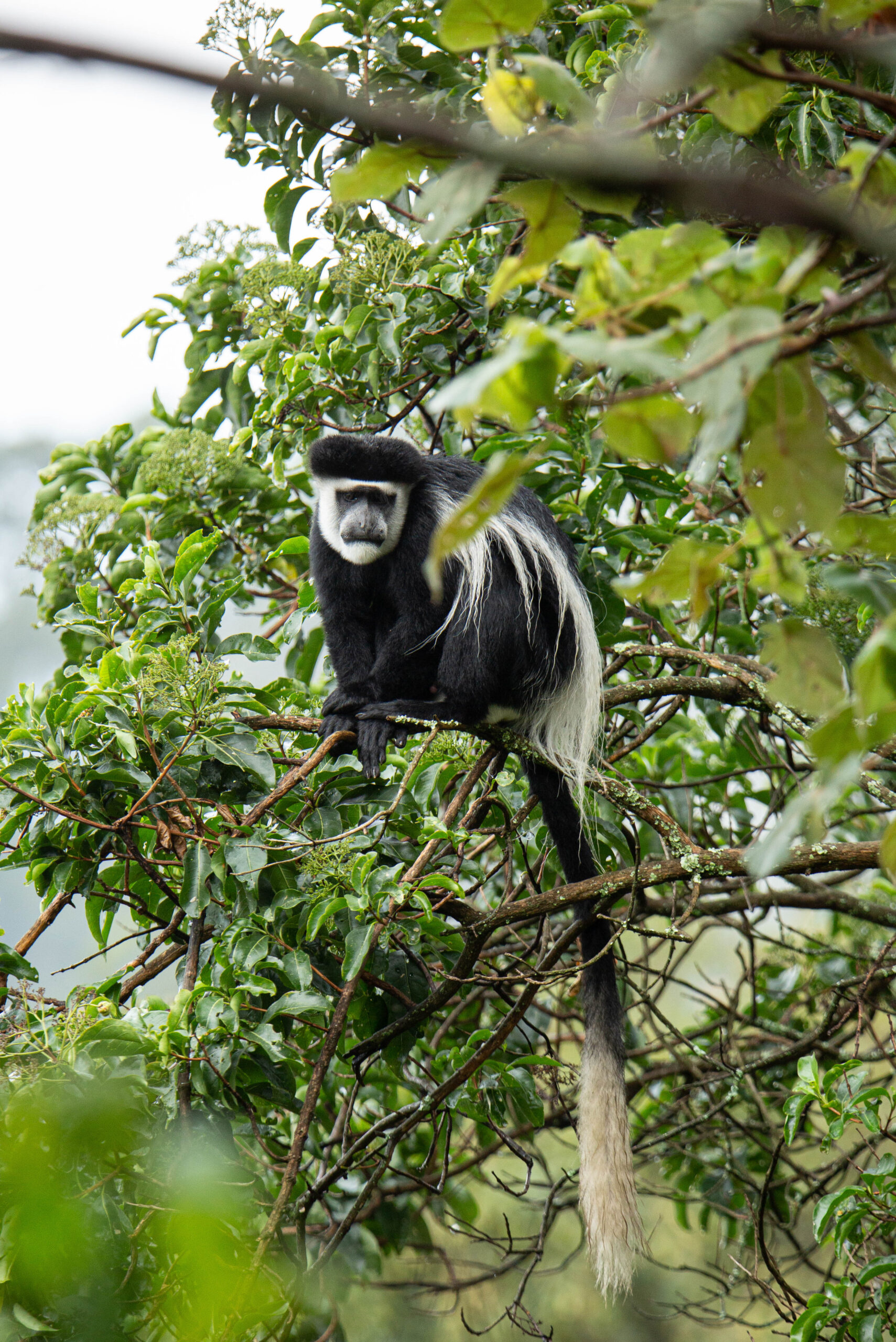Black and white colobus monkeys, scientifically known as Colobus guereza, are fascinating creatures that inhabit the dense forests of Africa. With their distinctive black fur and striking white mantle, these primates are a captivating sight to behold. In this essay, we will explore the characteristics, behavior, habitat, and conservation status of black and white colobus monkeys, shedding light on the unique aspects of their existence in the natural world.
Physical Characteristics:
These colobus monkeys are known for their striking coloration. Their black fur provides a stark contrast against the snowy white mantle that drapes across their shoulders, giving them a distinctive appearance. Unlike many other primates, colobus monkeys lack a thumb, which is an adaptation that aids in their arboreal lifestyle. They possess a long tail that helps them maintain balance as they move skillfully through the trees.

Behavioral Traits:
Colobus monkeys are highly social creatures, living in troops consisting of several individuals. These troops are usually led by a dominant male and comprise females, offspring, and sometimes additional males. They communicate using a combination of vocalizations, such as barks and hoots, as well as body postures and facial expressions.
One remarkable aspect of their behavior is their dietary preferences. These colobus monkeys are primarily folivorous, meaning their diet primarily consists of leaves. They possess a specialized digestive system that enables them to break down tough plant materials efficiently. However, they also consume fruits, seeds, flowers, and occasionally insects to supplement their nutritional needs.
Habitat and Distribution:
These monkeys are native to the forests of Central and East Africa. They can be found in countries such as Kenya, Uganda, Tanzania, Rwanda, and the Democratic Republic of Congo. These primates are predominantly arboreal, spending most of their lives in the treetops of various forest types, including tropical rain-forests, montane forests, and gallery forests along riverbanks.
Their arboreal lifestyle provides them with protection from ground-dwelling predators and allows them to exploit the abundant food resources found in the forest canopy. The dense forests also provide them with ample cover and a network of branches for easy movement.

Where can i see the Black and white colobus monkeys in Uganda?
- In Uganda, you can see black and white colobus monkeys in various national parks and forest reserves. One of the popular locations to spot these monkeys is Kibale National Park, located in the western part of Uganda. Kibale National Park is renowned for its diverse primate population, including a large number of black and white colobus monkeys.
- Another option is Queen Elizabeth National Park, which is situated in western Uganda as well. While the park is primarily known for its abundant wildlife and scenic beauty, it is also home to black and white colobus monkeys.
- Additionally, Murchison Falls National Park, located in northern Uganda, is known for its chimpanzees and other primates, including black and white colobus monkeys. Exploring the forested areas of the park can provide opportunities for observing these fascinating creatures.
- Not forgetting, Bwindi Impenetrable Forest in Bwindi Impenetrable National Park is another important destination to see these primates. This UNESCO site is among the oldest in Africa, having a wide primate count including black and white colobus monkeys.
- Lastly, Mgahinga Gorilla National Park in southwestern Uganda is part of the larger Virunga Conservation Area. This park is known for its mountain gorillas, but it is also home to black and white colobus monkeys.

Remember to check with the local authorities, such as Uganda Wildlife Authority, for updated information and guidance on the best locations and guidelines for viewing black and white colobus monkeys during your visit.
Conservation Status:
These colobus monkeys face several threats to their survival. Habitat loss due to deforestation is one of the primary challenges they encounter. As human populations expand and demand for resources increases, their forest habitats are being cleared for agriculture, logging, and infrastructure development.
Additionally, these monkeys are hunted for their fur and body parts, as well as captured for the illegal pet trade. These activities, coupled with the slow reproductive rate of colobus monkeys, pose significant risks to their populations.
Efforts are being made to conserve these monkeys and their habitats. Conservation organizations work towards establishing protected areas, conducting research, raising awareness, and implementing measures to mitigate human-wildlife conflicts. Encouraging sustainable practices and promoting responsible tourism can also contribute to their long-term conservation.
Book an 8 days primate safari
Conclusion:
Black and white colobus monkeys are captivating creatures that grace the forests of Africa with their contrasting appearance and unique adaptations. Their social behavior, specialized diet, arboreal lifestyle, and specific habitat requirements make them fascinating subjects of study and conservation efforts. By understanding and appreciating these remarkable primates, we can work towards preserving their habitats and ensuring their continued existence in the wild for generations to come.







